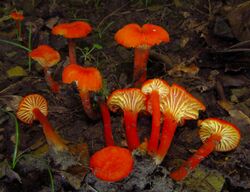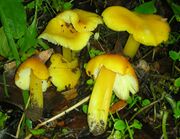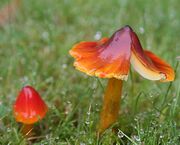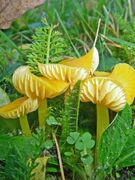Biology:Hygrocybe
| Hygrocybe | |
|---|---|

| |
| Hygrocybe cantharellus | |
| Scientific classification | |
| Domain: | Eukaryota |
| Kingdom: | Fungi |
| Division: | Basidiomycota |
| Class: | Agaricomycetes |
| Order: | Agaricales |
| Family: | Hygrophoraceae |
| Genus: | Hygrocybe (Fr.) P.Kumm. (1871) |
| Type species | |
| Hygrocybe conica (Schaeff.) P.Kumm. (1871)
| |
| Synonyms[1] | |
| |
Hygrocybe is a genus of agarics (gilled fungi) in the family Hygrophoraceae. Called waxcaps in English (sometimes waxy caps in North America), basidiocarps (fruit bodies) are often brightly coloured and have dry to waxy caps, white spores, and smooth, ringless stems. In Europe they are characteristic of old, unimproved grasslands (termed waxcap grasslands) which are a declining habitat, making many Hygrocybe species of conservation concern. Four of these waxcap-grassland species, Hygrocybe citrinovirens, H. punicea, H. spadicea, and H. splendidissima, are assessed as globally "vulnerable" on the IUCN Red List of Threatened Species.[2] Elsewhere waxcaps are more typically found in woodlands. Most are ground-dwelling and all are believed to be biotrophs. Around 150 species are recognized worldwide. Fruit bodies of several Hygrocybe species are considered edible and are sometimes offered for sale in local markets.
Taxonomy
History
Hygrocybe was first published in 1821 by Swedish mycologist Elias Magnus Fries as a subsection of Agaricus and in 1871 was raised to the rank of genus by Kummer. In several papers, Karsten and Murrill used the name Hydrocybe, but this is now taken as an orthographic variant of Hygrocybe. The generic name is derived from the Greek ῦγρὁς (= moist) + κυβη (= head).[3][4]
Despite its comparatively early publication, the genus Hygrocybe was not widely accepted until the 1970s, most previous authors treating it as a synonym of Hygrophorus, a related genus of ectomycorrhizal agarics.[3][5]
Current status
Recent molecular research, based on cladistic analysis of DNA sequences, has shown that Hygrocybe sensu lato is paraphyletic and does not form a single clade within the Hygrophoraceae. As a result, many species formerly referred to Hygrocybe have been transferred to the genera Chromosera, Cuphophyllus, Gliophorus, Gloioxanthomyces, Humidicutis, Neohygrocybe, or Porpolomopsis.[6][7][8][9] This leaves Hygrocybe sensu stricto as a smaller but more cohesive genus of species related to the type, Hygrocybe conica.
Description
Fruit bodies of Hygrocybe species are all agaricoid, most (but not all) having smooth to slightly scaly caps that are convex to conical and dry to waxy or viscid when damp. Many (but not all) are brightly coloured in shades of red, orange, or yellow. Where present, the gills beneath the cap are often equally coloured and usually distant, thick, and waxy. One atypical South American species, Hygrocybe aphylla, lacks gills.[10] The stems of Hygrocybe species lack a ring. The spore print is white. Fruit bodies of some species, notably Hygrocybe conica, blacken with age or when bruised. Microscopically, Hygrocybe species lack true cystidia and have comparatively large, smooth, inamyloid basidiospores.[11]

Habitat, nutrition, and distribution
Species of Hygrocybe are soil-dwelling. In Europe, most species are typical of unimproved (nutrient-poor), short-sward grasslands, often termed "waxcap grasslands",[12] but elsewhere they are more commonly found in woodland.
Their metabolism has long been debated, but recent research suggests that they are not saprotrophic[13][14] but rather symbiotically associated with the roots of higher plants or mosses. Hyphae of H. conica have been detected in plant roots.[14]
Species are distributed worldwide, from the tropics to the sub-polar regions. Around 150 have been described to date.[15] Waxcaps receive most attention in northern Europe,[16] where they are found in nutrient-poor pastures.[11] However, outside Europe, waxcaps are more commonly associated with woodland habitats, for example the sclerophyll forests site at Lane Cove Bushland Park and Ferndale Park, Sydney.[17]
Conservation
In Europe, waxcap grasslands and their associated fungi are of conservation concern, since unimproved grasslands (formerly commonplace) have declined dramatically as a result of changes in agricultural practice. This decline has led to four European Hygrocybe species, Hygrocybe citrinovirens, H. punicea, H. spadicea, and H. splendidissima, being assessed as globally "vulnerable" on the IUCN Red List of Threatened Species.[2]
Elsewhere, several rare and localized endemic species are assessed as globally "endangered" on the IUCN Red List of Threatened Species.[2] They include Hygrocybe boothii in Australia, Hygrocybe noelokelani and Hygrocybe pakelo in Hawaii, Hygrocybe striatella in Chile, and Hygrocybe flavifolia in California.
Economic usage
Because Hygrocybe species cannot be maintained in culture,[18] none is cultivated commercially. Fruit bodies of a few species are considered edible in eastern Europe, south-east Asia, and Central America and are collected and consumed locally.[19]
Literature
No comprehensive monograph of the genus has yet been published. In Europe, however, species of Hygrocybe have been illustrated and described in a standard English-language guide by Boertmann (2010)[11] and also (together with Hygrophorus) in an Italian guide by Candusso (1997).[20] European species have also been covered, more briefly, in descriptive French keys by Bon (1990).[21] Dutch species were illustrated and described by Arnolds (1990).[22] No equivalent modern guides have been published for North America, the most recent being by Hesler & Smith (1963).[5] There is, however, a guide to Californian species by Largent (1985).[23] In Australia, Hygrocybe species have been illustrated and described by Young (2005)[24] and in New Zealand by Horak (1990).[25]
Species
References
- ↑ "Hygrocybe (Fr.) P. Kumm.". MycoBank. International Mycological Association. http://www.mycobank.org/MycoTaxo.aspx?Link=T&Rec=17806.
- ↑ 2.0 2.1 2.2 "Hygrocybe: The IUCN Red List of Threatened Species". https://www.iucnredlist.org/search?query=hygrocybe&searchType=species.
- ↑ 3.0 3.1 Rea C. (1922). British Basidiomycetaceae: A Handbook of the Larger British Fungi. Cambridge, UK: Cambridge University Press. pp. 799.
- ↑ Cornelis, Schrevel (1826). Schrevelius' Greek lexicon, tr. into Engl. with numerous corrections. pp. 184–186. https://books.google.com/books?id=2eUIAAAAQAAJ&dq=%CE%BA%CF%8D%CE%B2%CE%B7&pg=PA358. Retrieved 2011-10-04.
- ↑ 5.0 5.1 North American species of Hygrophorus. University of Tennessee Press. 1963. pp. 416. http://www.hti.umich.edu:80/cgi/t/text/text-idx?c=fung1tc;cc=fung1tc;view=toc;idno=AJN5962.0001.001.
- ↑ "Recent advances in molecular phylogeny of temperate Hygrophoraceae and concordance with morphology and ecology (abstract)". IMC7 Abstracts (146). 2002. http://www.nhm.uio.no/cgi-bin/imc7_abs.pl?rn=146.[yes|permanent dead link|dead link}}]
- ↑ "Major clades of Agaricales: a multilocus phylogenetic overview". Mycologia 98 (6): 982–95. 2006. doi:10.3852/mycologia.98.6.982. PMID 17486974. http://www.clarku.edu/faculty/dhibbett/Reprints%20PDFs/Mathenyetal_Agaricales_2006.pdf.
- ↑ "Preliminary notes on dual relevance of ITS sequences and pigments in Hygrocybe taxonomy". Persoonia 26: 99–107. 2011. doi:10.3767/003158511X578349. PMID 22025807.
- ↑ Lodge, D. Jean; Padamsee, Mahajabeen; Matheny, P. Brandon; Aime, M. Catherine; Cantrell, Sharon A.; Boertmann, David; Kovalenko, Alexander; Vizzini, Alfredo et al. (2014-01-01). "Molecular phylogeny, morphology, pigment chemistry and ecology in Hygrophoraceae (Agaricales)" (in en). Fungal Diversity 64 (1): 1–99. doi:10.1007/s13225-013-0259-0. ISSN 1560-2745. https://iris.unito.it/bitstream/2318/136089/1/1205754_Molecular%20phylogeny.pdf.
- ↑ "A new alamellate Hygrocybe species from Ecuador". Mycological Research 112 (Pt 10): 1206–1209. 2008. doi:10.1016/j.mycres.2008.04.002. PMID 18703325.
- ↑ 11.0 11.1 11.2 Boertmann D. (2010). The genus Hygrocybe (2nd ed.). Copenhagen: Danish Mycological Society. pp. 200. ISBN 978-87-983581-7-6.
- ↑ "Waxcap-grassland survey". The Mycologist 10: 23–25. 1996. doi:10.1016/s0269-915x(96)80046-2.
- ↑ "Conservation of biotrophy in Hygrophoraceae inferred from combined stable isotope and phylogenetic analyses". Mycologia 103 (2): 280–290. 2011. doi:10.3852/10-195. PMID 21139028.
- ↑ 14.0 14.1 Halbwachs, Hans; Dentinger, Bryn T.M.; Detheridge, Andrew P.; Karasch, Peter; Griffith, Gareth W. (December 2013). "Hyphae of waxcap fungi colonise plant roots". Fungal Ecology 6 (6): 487–492. doi:10.1016/j.funeco.2013.08.003. ISSN 1754-5048.
- ↑ Dictionary of the Fungi (10th ed.). Wallingford, UK: CABI. 2008. p. 446. ISBN 978-0-85199-826-8.
- ↑ Griffith, G.W.; Gamarra, J.G.P.; Holden, E.M.; Mitchel, D.; Graham, A.; Evans, D.A.; Evans, S.E.; Aron, C. et al. (30 August 2014). "The international conservation importance of Welsh 'waxcap' grasslands". Mycosphere 4 (5): 969–984. doi:10.5943/mycosphere/4.
- ↑ Protecting and restoring the fungi (sic) community of Lane Cove Bushland Park. Department of Environment and Climate Change NSW. 2008. ISBN 978-1-74122-965-3. http://www.environment.nsw.gov.au/resources/threatenedspecies/08278tsdsfungi.pdf. Retrieved 18 May 2018.
- ↑ "Ecology and diversity of waxcap (Hygrocybe spp) fungi". Botanical Journal of Scotland 54: 7–22. 2002. doi:10.1080/03746600208685025. http://www.aber.ac.uk/waxcap/downloads/ecology-diversity.doc.
- ↑ Boa ER. (2004). Wild edible fungi: a global overview of their use and importance to people. Food and Agriculture Organization of the United Nations. p. 147. ISBN 978-92-5-105157-3. https://books.google.com/books?id=Zd2NlcNZgvcC.
- ↑ Candusso M. (1997). Fungi Europaei 6: Hygrophorus s.l.. Alassio, Italy: Libreria Basso. pp. 784.
- ↑ Bon M. (1990) (in fr). Flore mycologique d'Europe 1: Les Hygrophores. Amiens Cedex: CRDP de Picardie. pp. 99.
- ↑ Arnolds E. (1990). Genus Hygrocybe in Flora Agaricina Neerlandica 2. Lisse, Netherlands: AA Balkema. pp. 71–111. ISBN 978-90-6191-971-1.
- ↑ Largent DL. (1985). The Agaricales (Gilled Fungi) of California 5: Hygrophoraceae. Eureka, California: Mad River Press. pp. 220. ISBN 978-0-916422-54-7.
- ↑ Young AM. (2005). Fungi of Australia: Hygrophoraceae. Collingwood, Victoria: CSIRO Publishing. pp. 188. ISBN 978-0-643-09195-5.
- ↑ Horak E. (1990). "Monograph of the New Zealand Hygrophoraceae (Agaricales)". New Zealand Journal of Botany 28 (3): 255–309. doi:10.1080/0028825x.1990.10412313. http://www.royalsociety.org.nz/media/publications-journals-nzjb-1990-029.pdf.[yes|permanent dead link|dead link}}]
External links
- WaxCap Website, University of Wales, Aberystwyth
Wikidata ☰ Q520530 entry
 |





